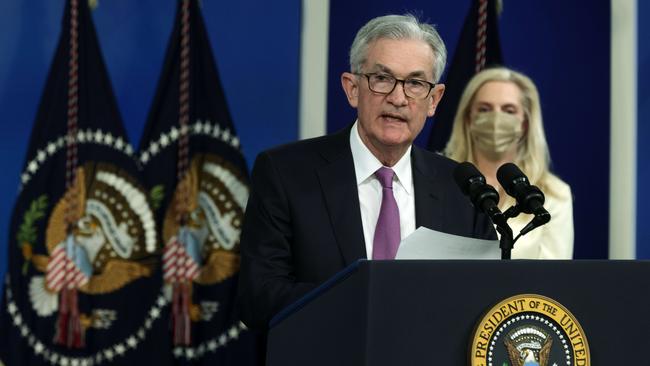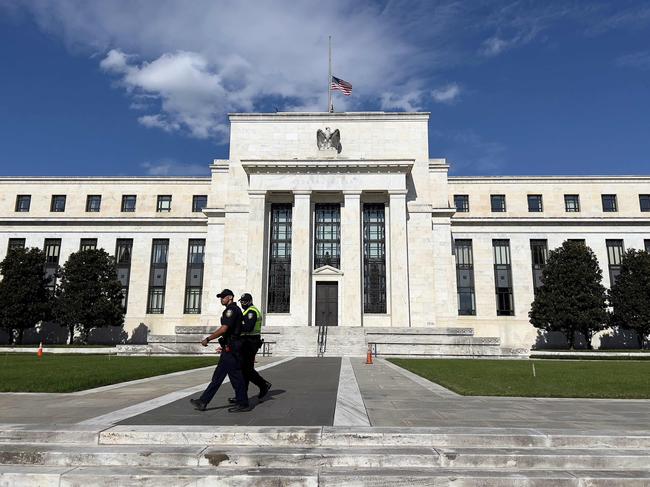Jerome Powell will face a very different economy in a second term as US Federal Reserve chairman
If inflation stays high, the Fed chairman must pivot from dove to hawk, at risk of recession and political blowback.

Over his first term in office, Jerome Powell became arguably the most dovish chairman in the Federal Reserve’s modern history, giving priority to full employment in an era in which inflation seemed extinct. In his second term, he may have to execute the reverse: giving priority to inflation at the risk of sacrificing jobs.
The pivot could be painful for both Mr Powell and President Joe Biden. On Monday, Mr Biden praised Mr Powell for his commitment to “maximum employment” so that “American workers get steady wage increases after decades of stagnation, and … the benefits of economic growth are broadly shared.” Yet economic conditions have been substantially reordered in just the past year. Inflation, at 6.2 per cent, is its highest in 31 years. While employment remains 4.2 million below its pre-pandemic peak, labour shortages are widespread, and wage growth is accelerating. All that threatens the Fed’s 2 per cent inflation target.
For now, Mr Powell and his colleagues including governor Lael Brainard, whom Mr Biden plans to nominate as vice chairwoman, hope and expect inflation to drop, as pandemic-related obstacles recede. But the risk is growing that the assumptions that undergirded Mr Powell’s dovish turn are out of date. If so, interest rates may need to rise a lot, threatening a recession and Mr Biden’s political fortunes.
Mr Powell, who goes by Jay, was no one’s pick for monetary revolutionary. A former private-equity executive and Treasury official under George H.W. Bush, he was appointed a Fed governor in 2012 by then-president Barack Obama, who needed a moderate Republican for partisan balance. His first instincts were hawkish, expressing discomfort with the Fed’s buying bonds to hold down long-term rates.
But Mr Powell is also open-minded. In conversation he calls himself a fox rather than a hedgehog, a nod to philosopher Isaiah Berlin’s taxonomy of hedgehogs, driven by a single overarching principle, and foxes, who draw upon disconnected and changing information.
By 2018, when then-President Donald Trump had made Mr Powell Fed chairman, he had shed his hawkish instincts. Central banking models, he said in a speech that year, relied on economic concepts that were imprecise or unobservable, a natural unemployment rate below which inflation accelerated or a neutral interest rate that perfectly balanced unemployment and inflation. Events bore him out: Unemployment steadily fell, reaching a 50-year low of 3.5 per cent, with no sign of troubling wage and price inflation. In fact, inflation persistently undershot the Fed’s 2 per cent target, prompting Mr Powell in 2019 to reverse a modest increase in interest rates.
Covid-19 reinforced this dovish tilt last year, as unemployment shot to a post-Depression record of nearly 15 per cent and inflation plummeted to 0.2 per cent. The Fed slashed interest rates to near zero, restarted buying bonds and lent vast sums to companies and market participants to stave off a financial crisis, efforts in which Ms. Brainard played a key part.
That summer, Mr Powell and his colleagues overhauled the Fed’s monetary framework. The Fed would now aim not just to return inflation to 2 per cent but to a bit above the target, so that over time, inflation would average 2 per cent. The central bank would no longer regard any level of unemployment as too low, reflecting a new-found “appreciation for the benefits of a strong labour market, particularly for many in low- and moderate-income communities,” Mr Powell said in a speech.
The Fed also pledged to keep interest rates near zero until inflation was headed above 2 per cent and the labour market had returned to maximum employment.

Many progressives had urged Mr Biden to replace Mr Powell, a Republican, with Ms Brainard, a Democrat who has been more proactive on climate and bank regulation. Mr Trump had set the precedent, replacing Democratic economist Janet Yellen, now Mr Biden’s Treasury secretary, with Mr Powell as Fed chief. But others said Mr Powell’s commitment to full employment mattered more. “Jay is about as dovish as a 68-year-old white Republican can go,” said Tim Duy, chief U.S. economist at SGH Macro Advisors.
But the economy today doesn’t look like the one that drove the Fed’s dovish makeover. Fearing that demand would be chronically weak as it was after the 2007-09 financial crisis, Mr Powell backed Congress in passing $US5.9 trillion in relief and stimulus. Demand now is red-hot, fuelled by that stimulus, low interest rates, the reopening of businesses and vaccinations. Meanwhile supply has been hobbled by shortages of key components and millions of workers’ exit from the labour force because of retirement, Covid-19 and other factors. As a result inflation has gone from undershooting to vastly overshooting the Fed’s 2 per cent target.
Mr Powell assumed from the previous economic recovery that the inflationary consequences of a tight job market were overblown. Yet today, with unemployment of 4.6 per cent, still well above its pre-pandemic low, strong demand and labour shortages have propelled wage growth to around a 6 per cent annual rate in the third quarter. If sustained, that wage growth isn’t compatible with inflation falling back to near 2 per cent, Goldman Sachs economists say. (They think it won’t be sustained.)
The Fed concluded from the previous recovery that “pre-emptive” tightening — raising interest rates ahead of inflation actually accelerating — unnecessarily choked off job growth. The central bank thus has kept rates near zero and increasingly negative when adjusted for inflation as the economy boomed and inflation accelerated. “While the Fed has raised rates too much too soon in the past, this alternative timing may result in the opposite error,” said Jason Furman, who chaired Mr Obama’s Council of Economic Advisers, in a Nov. 18 analysis.
Inflation should ease next year, as supply chains normalise and energy prices stop rising; the big question is where it levels out.
Fed officials, and most private economists, think inflation will stabilise between 2 per cent and 2.5 per cent, a welcome offset to years of sub-2 per cent inflation.
Markets are less sanguine: On Friday, inflation-indexed securities were projecting consumer price inflation at 3 per cent through 2023 before falling to between 2 per cent and 2.5 per cent in later years. (Those figures would be slightly lower using the Fed’s preferred price index.)
If inflation stays at 3 per cent or higher, Mr Powell would, foxlike, have to amend his assumptions and weigh sharply higher interest rates to cool off the economy.
Such a strategy carries multiple risks.
It could undermine stock and real-estate values that have been underpinned by exceptionally low rates. As interest on the massive federal debt mounts, the budget deficit could soar. Sharply higher rates could also push up unemployment, which historically has always ended in recession. If the inflation scare proves a false alarm, the Fed may inadvertently pitch the economy back into the pre-pandemic status quo of low growth, low inflation, and ultimately low interest rates.
The risks include political blowback, for the Fed and Mr Powell personally. The public hates inflation, but won’t thank the Fed for higher unemployment, either. “People underestimate the political challenge of being a central bank that lets inflation get too high and then has to unwind that quickly,” said Mr Duy. Whereas Mr Trump repeatedly pressured Mr Powell to adopt easier monetary policy, Mr Biden has promised to respect the Fed’s independence. Indeed, some analysts warned that nominating Ms. Brainard, with her more dovish reputation, would imply inflation wasn’t being taken seriously. Nonetheless, Mr Biden has other ways to influence monetary policy. He could fill three coming vacancies on the Fed’s seven-member board with governors less aligned with Mr Powell’s priorities. Conversely, Mr Powell could face attacks from Republicans if he fails to rein in price pressures.
While Mr Powell, a lawyer by training, lacks his predecessors’ economic credentials, he makes up with exceptional political acumen. He resisted Mr Trump’s pressure without alienating other Republicans. He meets regularly with legislators for both parties and is likely to be confirmed with widespread bipartisan support. Whether or not reappointing Mr Powell ultimately helps Mr Biden, the decision has shored up the Fed’s reputation for nonpartisanship, a commodity in short supply these days.
The Wall Street Journal



To join the conversation, please log in. Don't have an account? Register
Join the conversation, you are commenting as Logout